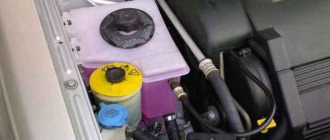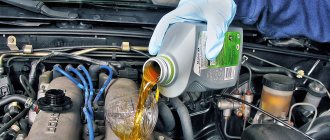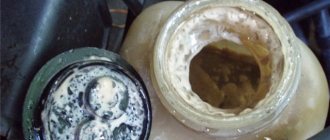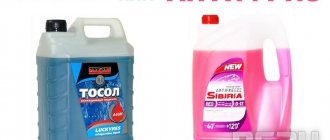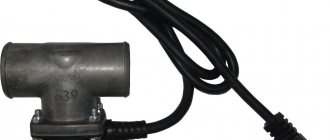Domestic antifreeze - composition and labeling
This product is a liquid that circulates in the cooling system. It is also one of the varieties of antifreeze based on ethylene glycol, but only domestically produced. Its main tasks are to cool the engine in warm weather and prevent freezing of the working fluid in winter, as well as to protect the internal container from corrosion .
Depending on the labeling, the composition of the antifreeze, its density and, accordingly, its properties will vary. The following indices are used in the classification: A, M, K, 30, 40, 65. The letters indicate the type and are deciphered accordingly - automobile, modernized and concentrate. The numbers are the freezing temperature of this model of domestic antifreeze. The markings may also contain abbreviations for the names of manufacturers.
There are no coolants with a freezing point below 65 degrees Celsius, and it is the concentration of a substance such as ethylene glycol that provides different crystallization conditions. In addition to it, any, even domestic, antifreeze includes a set of additives, usually about 8–15, their purpose is to protect all pipes and components of the system from corrosion.
Features of antifreeze production
Nowadays no one pours water into the radiator and expansion tank, as our grandfathers did. At least in the cold season. There is a wonderful substance that, when exposed to negative temperatures, does not freeze, but simply thickens. Every driver is familiar with antifreeze. To open such a business, you do not need to obtain a license; it all comes down to obtaining standard permits and registering a trademark.
Not every antifreeze is created equal
Antifreeze liquids can contain various chemicals. You, as a future businessman, must choose the best formula for yourself that will make your product competitive and attractive for continuous use.
- Adding a saline solution or hydrochloric acid will help achieve a non-freezing effect, but such antifreeze will not be successful, since the effect on the metal has an extremely negative effect.
- Alcohol-containing antifreeze antifreezes are now not used as widely as we would like.
- Glycol antifreezes are now the most popular and widespread. They are not afraid of frost even at -60 degrees.
In addition to the main substance, it is necessary to add fragrance, demineralized water and dye to the antifreeze composition.
We research the sales market
Having decided what kind of antifreeze will be produced at the future enterprise, you can move on to the next stage on the path to building a business with your own hands. And it consists of conducting marketing research on the characteristics of the automotive chemicals market. You will need to cover not only your region, but also neighboring ones.
The ideal option would be to conclude an agreement for the supply of antifreeze with at least one enterprise. It is worth trying to achieve government support, citing the fact that your business provides new jobs and contributes to the economic development of the region.
Antifreeze - technical specifications and purchase rules
Once at the counter in an auto store, most are perplexed as to which color of antifreeze is better, because they were not prepared for such variety. The answer is not that complicated! This parameter does not affect any quality characteristics; it is just a dye added by the manufacturer. Its main purpose is to differentiate brands and allow them to be mixed, for example, in model “40” the liquid is often blue, and “65” is red. It is also used for safety, since without dye, antifreeze has a transparent white color.
The boiling point of antifreeze usually lies in the range of 104–112 degrees Celsius; as for imported antifreeze manufacturers, it reaches 120–130. When purchasing, one of the ways to check quality is to measure the density; a good indicator is the limit from 1.060 to 1.090 g/cm 3 . Before going to the store, you need to determine what brand of coolant is in your car, and to do this, you should refer to the owner's manual. You can also find application rules there.
Types of non-freezing liquid for heating
Factory antifreeze for heating
Having determined that non-freezing coolants for the heating system should only be of factory quality, you can begin to select a specific composition. It must be adapted to a specific heat supply scheme, and its performance indicators cannot worsen the parameters of the system.
Before pouring non-freezing liquid into the heating system, you need to find out whether it will negatively affect the heating components. To do this, you should read the instructions for use, which must be included. It is also important to pay attention to the main component of the antifreeze fluid for heating boilers. Not only the condition of the heat supply components, but also the operating conditions depend on this:
- Ethylene glycol . Characterized by high toxicity. Therefore, it can only be used in closed circuits. Difficulties may arise when pouring this type of freezing liquid into the heating system. In a vapor state, it is hazardous to human health;
- Propylene glycol . In fact, it is a food additive, so it can be used in both open and closed heating systems. In contrast to ethylene glycol, the crystallization temperature is +80°C, which makes it possible to use it to operate high-temperature solid fuel boilers. The only drawback is the high cost;
- Glycerin . The most popular type of non-freezing liquid for stove heating. Its performance qualities are slightly lower than those of propylene glycol. However, at the same time, the cost of glycerin antifreeze is an order of magnitude less. Disadvantages include high turnover. This may affect the tightness of the pipelines. The solution is to replace the rubber gaskets with paronite gaskets.
Currently, the use of non-freezing liquid for a home heating system based on glycerin is the best option.
| Name | Compound | Price, rub/l |
| Warm house -30°С | Propylene glycol | 65 |
| Dixis -65 | Glycerol | 75 |
| Coziness Technology -65 | Ethylene glycol | 120 |
Manufacturers offer 2 types of non-freezing coolants for heating systems - ready-to-use and concentrate. For large heat supply schemes, it is more profitable to purchase concentrate. However, this complicates the process of filling the system.
When purchasing ready-to-use liquid, you need to pay attention to the lower critical level of freezing temperature. It can be from -25°C to -65°C.
We will replace the coolant yourself
Despite numerous warnings, antifreeze and antifreeze can be mixed, but some details need to be taken into account. It is best if the liquids are the same color and from the same manufacturer; you can also merge different colors, although the probability of success here is small, but still possible. So, you need to mix them together and wait for some time. If sediment appears in the new mixture, then you risk ruining the system, and if there is none, you can pour it all into the tank.
The appearance of sediment is a signal that the compounds are incompatible, and their mixture may have dangerous properties for your car. Now about the replacement process itself. Under no circumstances should you open the radiator cap when the engine is hot. Park your car in a place where there is no slope, this will ensure 100% drainage of the waste fluid. To remove the old compound, in addition to the top one, you also need to unscrew the bottom cap on the radiator. Do not forget to first place a sufficient container under it for waste.
After flushing the entire cooling system and tightly screwing the lower outlet plug, the long-awaited replacement occurs, where antifreeze is poured in in this case, it’s easy to guess - this is the upper hole. We fill the system with liquid as much as possible, and then seal it. To do this, we start the car and monitor the temperature sensor, it should show the norm, after that we top up the composition again to the top, and the process is completed. After all the operations performed, it is important to monitor the heating of the engine for some time; it should not exceed the permissible values.
The article presents the recipe for antifreeze , a substance intended for cooling in modern cars and other vehicles.
Since ancient times, drivers have poured water into the radiator of their car. To prevent it from freezing, a special substance was first added - ethylene glycol . The resulting mixture did not pose a danger to the cylinder block and radiator, since it turned into a viscous paste with small pieces of ice that were not prone to rupture of automotive equipment. For old cars that had cast iron engines and brass radiators, this substance seemed almost an ideal option, since it was also safe in terms of corrosion. This is how antifreeze appeared, which literally means “against frost.”
Replacing antifreeze with your own hands
By regularly changing the antifreeze in the cooling system, you can ensure reliable operation of your car engine for many years. Automakers tend to regularly replace antifreeze after every 45 thousand kilometers to prevent engine failure due to overheating. A number of experts suggest changing antifreeze annually to prevent corrosion, especially of aluminum cylinder heads and car radiators. But it seems that this advice has already lost its meaning. The production of antifreeze has begun, the service life of which will reach 100 thousand kilometers. Manufacturers only advise against mixing the new product with old antifreeze remaining in the car’s cooling system. Otherwise, its anti-corrosion qualities may lose their activity.
As you know, the service life of antifreeze is determined by the composition of anti-corrosion additives (silicates, phosphates and borates). If the composition of these substances corresponds to the norm, the antifreeze does not need to be changed. But as soon as their number decreases, engines and radiators begin to electrolytically corrode. Aluminum parts of the cooling system and engine are especially susceptible to it. If there is a lack of anti-corrosion additives in antifreeze, destructive processes begin in aluminum parts of engines. Therefore, antifreeze must be replaced before the corrosion process begins.
To test the quality of antifreeze, special test strips are widely used. These stripes are advocated by most manufacturers of coolants, including antifreeze. When in contact with antifreeze, the strips change color and, by comparing them with a special scale, you can determine the quality of the antifreeze and decide whether to replace it.
Replacing antifreeze with your own hands is not at all difficult. Since antifreezes are very toxic, you must be extremely careful when working with them. Do not pour waste liquid into water bodies or near wells, pumps, etc.
Replacing antifreeze is carried out on a cold engine. Start by opening and removing the radiator cap. Next, open the radiator drain valve and drain the liquid into a bucket. The hoses are inspected to ensure their integrity. If there is a need, replace the hoses.
Before adding new antifreeze, the system is flushed to remove rust, grease and deposits that cannot be removed with water. The system is washed with a special detergent. It is necessary to pour the contents of the container with the product into the radiator and add clean water to the limit, not excluding the tank. The radiator cap must be replaced and the drain valve closed.
Then, turning on the engine and heating system to maximum modes, wait until operating temperature is established in the engine. Then the engine is turned off and time is given for it to cool down. After this, by removing the radiator cap, everything is drained from the system.
Then ordinary water is poured into the system, the lid is closed and the motor is turned on again for a quarter of an hour. And then the engine is cooled and the water is drained. Now it's time to fill in new antifreeze.
Filling with antifreeze must be done in accordance with the instructions from the manufacturer. The antifreeze poured into the system should not have a concentration of more than 70%, and its optimum is 50 to 50. After pouring new antifreeze, you need to start the engine and turn on the heating at full power to evenly distribute the antifreeze in the system components and allow air to escape from the system . After driving the car for some time, you need to check the degree of filling of the cooling system with antifreeze and, if necessary, add it to the required level.
pravauto.com
First problems
Along with the improvement of cars, the first troubles appeared. As it circulated through the new cooling systems, the heated antifreeze absorbed the metal. So the impeller and the walls of the cylinder head channels were left without whole pieces. Research institutes immediately began to solve this problem and proposed using additives in the form of inorganic salts to reduce corrosion activity. They contributed to the appearance on the walls of metal surfaces of a layer resistant to ethylene glycol.
At the same time, another name for antifreeze appeared - antifreeze . It appeared in a rather interesting way. The first three letters came from the department at the institute that dealt with the problems of improving antifreeze - “Organic Synthesis Technology”. The ending -ol is a tribute to chemical terminology. This is how the country first became acquainted with antifreeze!
Summarizing
Only the manufacturer can guarantee the wonderful qualities of anti-freeze products, so try to make purchases in the appropriate stores. It is worth knowing that, for example, with the first drop of antifreeze entering the depths of your heating system, the warranty on the water boiler is automatically voided (see also the article “Gas heating - cheap, efficient, reliable”).
Ask yourself, are you willing to constantly put yourself at risk by using dangerous ethylene glycol in your home's water heating system? Compared to this, vigilant vigilance over the amount of coolant in the system will seem like a trifle. It is logical to choose a safe coolant option and give yourself the opportunity to fully enjoy the benefits of civilization.
If you have never dealt with pouring antifreeze into a heating system, the video in the article will help you.
Did you like the article? Subscribe to our Yandex.Zen channel
So are there any differences?
We repeat - any coolant is antifreeze. Antifreeze is also antifreeze. Most sellers usually call antifreeze a liquid more intended for domestic cars. Although, even under the guise of “antifreeze” you can buy low-quality goods. To be confident in your choice, we recommend purchasing antifreeze only from well-known and trusted manufacturers. Preferably with reference to product endorsements by recognized automotive brands.
Antifreeze, what kind of liquid is it and why is it needed?
The distribution network receives antifreeze of different brands, which differ in quality, care for car parts (aggressiveness), boiling and freezing points, color (can be red, green, blue).
If we take into account anti-corrosion additives, then silicate or carboxylate varieties may be present in antifreeze. It should be noted that when using silicate antifreeze, over time, the entire internal surface of the cooling system becomes covered with scale, and accordingly, a decrease in heat transfer occurs, i.e. the cooling efficiency drops.
Silicate antifreeze can be distinguished by its blue or green color.
Antifreeze created on a carboxylate basis contains special anti-corrosion additives, which are products of the processing of organic acids. The places where these additives, which are corrosion inhibitors, accumulate are precisely those areas that could potentially suffer from corrosion, and during the process of adsorption, several layers of protection are formed on fragments of parts, less than 0.1 microns thick.
The service life of the carboxylate product is 5 years, which is 2 years longer than the shelf life of the silicate analogue, it has higher cleaning properties. When replacing carboxylate antifreeze, it is not necessary to flush the cooling system.
As a rule, the color of the commercially available carboxylate product is red.
Detailed antifreeze recipe
Of course, not every driver can afford to buy expensive antifreeze from well-known manufacturers and suppliers. Most likely, this is why many car owners began to look for an antifreeze formulation in order to save financial resources. In reality, everything turned out to be not so simple. Large companies do not give away trade secrets, which, without a doubt, include product recipes. This is their profit - everything is logical and understandable here. I had to experiment for a long time.
But with the development of information technology, data has become more accessible. In particular, databases of patents from the times of the Soviet Union were posted on the Internet, where you can find the antifreeze recipe. Here we present just a few options. Anyone with access to the network can significantly expand this database
You can make antifreeze for heating yourself
- You can make your own radiator mixture. To do this you will need: distilled water and 40% ethyl alcohol.
To use antifreeze in a heating system, it is not always possible to fill in ready-made commercial mixtures. In this case, you can use a coolant that can be easily prepared with your own hands. you ask how is this possible? Everything is very simple, this coolant is a non-freezing mixture of distilled water and forty percent ethyl alcohol. Such antifreeze, prepared with your own hands for the heating system, has the following characteristics:
- the viscosity of the liquid is slightly higher than that of water, but much lower than that of commercial antifreeze;
- Alcohol-based mixtures have another advantage, making them an excellent choice for metal radiators. The fact is that alcohol prevents the development of corrosion, and this is important for systems whose destruction can lead to a variety of troubles;
- in this case, it is recommended to use hard water for the heating system, which, together with alcohol, prevents the formation of scale on the internal surfaces. The sediment is formed in solid form; during preventive flushing it is very easily removed from the system;
- when the alcohol content in the mixture is 30 percent or more, it does not evaporate separately;
- The boiling point of the alcohol coolant is approximately equal to the value for ordinary water. That is, when the temperature rises to 85 degrees Celsius, it does not boil with the formation of large masses of steam;
- alcohol in the coolant composition reduces thermal expansion, that is, when freezing, heating pipes and other elements are not damaged.
fluidity is less than antifreeze, which makes it possible to somewhat reduce the requirements for the tightness of circuit connections. Rubber seals are not damaged when using this particular liquid;
If you have to choose between water and an alcohol mixture, many experts recommend giving preference to the second option (if the boiler design allows this). The proportions of this composition are calculated based on what temperature values are planned:
If for some reason the boiler is turned off, be sure to drain the hot water from the radiator, otherwise the pipes may burst.
- when the temperature drops to minus 10.6 degrees, the alcohol content should be 20.3 percent;
- when it drops to minus 23.6 degrees, the alcohol content is 33.8 percent;
- when freezing to minus 28.7 degrees, the alcohol content should be 39 percent;
- when reduced to minus 33.9 percent, the alcohol content is 46.3 percent.
When preparing coolant for aluminum radiators, the volume must be calculated based on the fact that one liter of 96% ethyl alcohol contains 960 ml of anhydrous alcohol. To obtain a 33% alcohol solution, you need to divide 96 by 33, which will give a volume of 2.9 liters. When adding 2.9 liters of water to one liter of alcohol, we obtain a 33% alcohol solution, which is an excellent coolant, poured into an aluminum radiator for the heating system. The resulting solution will not freeze even at temperatures down to minus 22.5 degrees.
About antifreeze
The first coolant that consumers persistently want to pour into the heating system as an antifreeze agent is ethylene glycol, propylene glycol, or otherwise antifreeze or antifreeze. As the manufacturers assure, in the production of such coolant based on ethylene glycol, they use a special package of anti-corrosion, anti-foam, anti-scale and stabilizing additives (inhibitors). A mixture of water and ethylene glycol has the unique property of not freezing at low (down to -70 ° C) temperatures. What do you actually put into your heating system:
— The physical qualities of water-glycol solutions are lower than those of water: they are distinguished by high kinematic and dynamic viscosity and density. In order to prevent loss of pressure in the heating system, the user will have to either purchase a more powerful pump or increase the speed of the existing unit.
— Antifreezes have a greater coefficient of volumetric expansion than water. Therefore, when converting heating systems from water to a non-freezing coolant, they are equipped with expansion tanks of larger volume.
— The heat capacity of water-glycol solutions is lower than the heat capacity of water (usually by 15-20%), and they transfer heat from the boiler to the radiator worse. Therefore, in order for the efficiency of heat transfer by the system to remain the same, the user will have to either use more powerful radiators or speed up its circulation in the system (i.e. operate the pump more intensively).
One of the most important disadvantages of ethylene glycol is that it easily dissolves oil-based paint used to seal joints in heating systems. If there are minor cracks in the system, then ethylene glycol begins to leak through them, and also negatively affects the rubber gaskets in the system, through which it eventually begins to flow.
And finally, the most important thing is Ethylene glycol - Poison!
https://spirtprom.com.ua/
From our experience in the operation of heating systems using antifreeze
1. Antifreeze in the heating system must be changed at least every 5 years, otherwise they lose their properties and
many precipitate and clog the pipes; even high-pressure flushing of the pipes does not help; as a result, the pipes have to be replaced. There were such cases this year as well; pipes on two systems were partially replaced and were clogged with a clay-like mixture. 2. After about 5-6 years, all rubber gaskets in the heating system become unusable and leaks appear; the rubber melts under the influence of antifreeze and turns into dust. The next time you change antifreeze, you have to change all the rubber gaskets. Therefore, we recommend alcohol-based antifreeze to our customers and the price is cheaper. We have been using this antifreeze for 3 years now and there are no leaks from the systems.
www.masterotoplenie50.ru
Why do you need to change antifreeze?
In order for the car to operate smoothly, it is necessary to replace the antifreeze in a timely manner. The timing of antifreeze replacement is determined, firstly, by the presence of anti-corrosion additives in its composition. As long as these substances are present in sufficient quantities, replacement does not need to be made.
A decrease in concentration to a certain level or its complete absence is a signal that replacement should be done urgently. Naturally, in order to find out the real amount of anti-corrosion additives, it will be necessary to periodically carry out diagnostic measures.
It is undesirable to wait until the moment when corrosion begins to corrode engine parts.
Restrictions on the use of antifreeze in heating supply
Despite all its positive aspects, not every non-freezing liquid is suitable for heating boilers. Improper use can lead to gradual destruction of the heat exchanger and rapid failure of expensive equipment.
In addition, there are a number of other restrictions that must be taken into account when using non-freezing coolant in heating systems:
- Many models of double-circuit boilers are not designed for antifreeze. It can get into the hot water supply system, which is an undesirable factor;
- Antifreeze liquid has a negative effect on galvanized surfaces. The protective layer quickly deteriorates and, as a consequence, the heating element fails;
- Since the viscosity of antifreeze is much higher than that of water, it is necessary to supplement the heating with powerful circulation pumps. The lower the critical level of freezing temperature, the greater the productivity of the pumps;
- Antifreeze replacement should be carried out strictly according to the manufacturer's recommendations. It loses its properties over time, which directly affects the performance of the heating system.
The antifreeze concentrate is diluted only with distilled water. An ordinary flow-through system is not suitable for this - a large number of third-party elements can cause an undesirable chemical reaction.
The video details the parameters for choosing antifreeze for heating systems:
Where is antifreeze poured?
According to the model and design of the car, antifreeze should be filled
into the expansion tank
or directly into the radiator.
The work should be done carefully, it is advisable to use a watering can and avoid spilling liquid.
Filling the container slowly will minimize the risk of air pockets.
